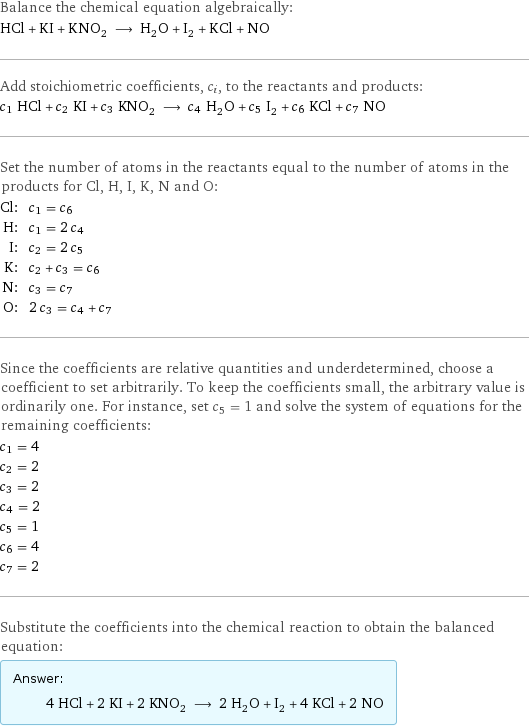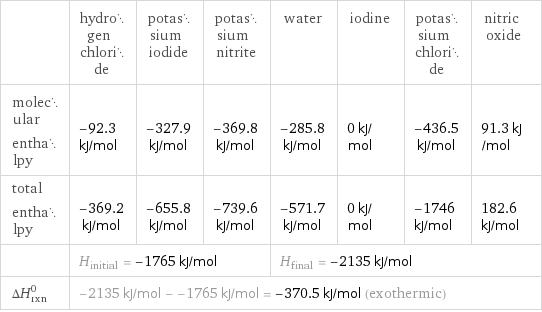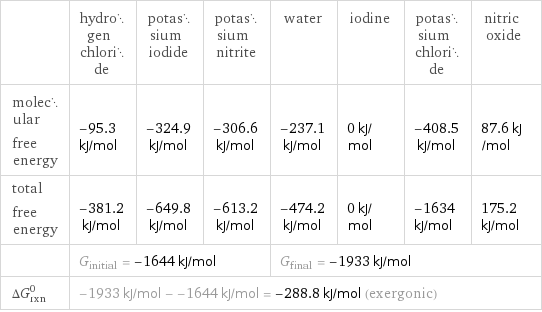Input interpretation

HCl hydrogen chloride + KI potassium iodide + KNO_2 potassium nitrite ⟶ H_2O water + I_2 iodine + KCl potassium chloride + NO nitric oxide
Balanced equation

Balance the chemical equation algebraically: HCl + KI + KNO_2 ⟶ H_2O + I_2 + KCl + NO Add stoichiometric coefficients, c_i, to the reactants and products: c_1 HCl + c_2 KI + c_3 KNO_2 ⟶ c_4 H_2O + c_5 I_2 + c_6 KCl + c_7 NO Set the number of atoms in the reactants equal to the number of atoms in the products for Cl, H, I, K, N and O: Cl: | c_1 = c_6 H: | c_1 = 2 c_4 I: | c_2 = 2 c_5 K: | c_2 + c_3 = c_6 N: | c_3 = c_7 O: | 2 c_3 = c_4 + c_7 Since the coefficients are relative quantities and underdetermined, choose a coefficient to set arbitrarily. To keep the coefficients small, the arbitrary value is ordinarily one. For instance, set c_5 = 1 and solve the system of equations for the remaining coefficients: c_1 = 4 c_2 = 2 c_3 = 2 c_4 = 2 c_5 = 1 c_6 = 4 c_7 = 2 Substitute the coefficients into the chemical reaction to obtain the balanced equation: Answer: | | 4 HCl + 2 KI + 2 KNO_2 ⟶ 2 H_2O + I_2 + 4 KCl + 2 NO
Structures

+ + ⟶ + + +
Names

hydrogen chloride + potassium iodide + potassium nitrite ⟶ water + iodine + potassium chloride + nitric oxide
Reaction thermodynamics
Enthalpy

| hydrogen chloride | potassium iodide | potassium nitrite | water | iodine | potassium chloride | nitric oxide molecular enthalpy | -92.3 kJ/mol | -327.9 kJ/mol | -369.8 kJ/mol | -285.8 kJ/mol | 0 kJ/mol | -436.5 kJ/mol | 91.3 kJ/mol total enthalpy | -369.2 kJ/mol | -655.8 kJ/mol | -739.6 kJ/mol | -571.7 kJ/mol | 0 kJ/mol | -1746 kJ/mol | 182.6 kJ/mol | H_initial = -1765 kJ/mol | | | H_final = -2135 kJ/mol | | | ΔH_rxn^0 | -2135 kJ/mol - -1765 kJ/mol = -370.5 kJ/mol (exothermic) | | | | | |
Gibbs free energy

| hydrogen chloride | potassium iodide | potassium nitrite | water | iodine | potassium chloride | nitric oxide molecular free energy | -95.3 kJ/mol | -324.9 kJ/mol | -306.6 kJ/mol | -237.1 kJ/mol | 0 kJ/mol | -408.5 kJ/mol | 87.6 kJ/mol total free energy | -381.2 kJ/mol | -649.8 kJ/mol | -613.2 kJ/mol | -474.2 kJ/mol | 0 kJ/mol | -1634 kJ/mol | 175.2 kJ/mol | G_initial = -1644 kJ/mol | | | G_final = -1933 kJ/mol | | | ΔG_rxn^0 | -1933 kJ/mol - -1644 kJ/mol = -288.8 kJ/mol (exergonic) | | | | | |
Equilibrium constant
![Construct the equilibrium constant, K, expression for: HCl + KI + KNO_2 ⟶ H_2O + I_2 + KCl + NO Plan: • Balance the chemical equation. • Determine the stoichiometric numbers. • Assemble the activity expression for each chemical species. • Use the activity expressions to build the equilibrium constant expression. Write the balanced chemical equation: 4 HCl + 2 KI + 2 KNO_2 ⟶ 2 H_2O + I_2 + 4 KCl + 2 NO Assign stoichiometric numbers, ν_i, using the stoichiometric coefficients, c_i, from the balanced chemical equation in the following manner: ν_i = -c_i for reactants and ν_i = c_i for products: chemical species | c_i | ν_i HCl | 4 | -4 KI | 2 | -2 KNO_2 | 2 | -2 H_2O | 2 | 2 I_2 | 1 | 1 KCl | 4 | 4 NO | 2 | 2 Assemble the activity expressions accounting for the state of matter and ν_i: chemical species | c_i | ν_i | activity expression HCl | 4 | -4 | ([HCl])^(-4) KI | 2 | -2 | ([KI])^(-2) KNO_2 | 2 | -2 | ([KNO2])^(-2) H_2O | 2 | 2 | ([H2O])^2 I_2 | 1 | 1 | [I2] KCl | 4 | 4 | ([KCl])^4 NO | 2 | 2 | ([NO])^2 The equilibrium constant symbol in the concentration basis is: K_c Mulitply the activity expressions to arrive at the K_c expression: Answer: | | K_c = ([HCl])^(-4) ([KI])^(-2) ([KNO2])^(-2) ([H2O])^2 [I2] ([KCl])^4 ([NO])^2 = (([H2O])^2 [I2] ([KCl])^4 ([NO])^2)/(([HCl])^4 ([KI])^2 ([KNO2])^2)](../image_source/c07327af0a391299084745650a2d3764.png)
Construct the equilibrium constant, K, expression for: HCl + KI + KNO_2 ⟶ H_2O + I_2 + KCl + NO Plan: • Balance the chemical equation. • Determine the stoichiometric numbers. • Assemble the activity expression for each chemical species. • Use the activity expressions to build the equilibrium constant expression. Write the balanced chemical equation: 4 HCl + 2 KI + 2 KNO_2 ⟶ 2 H_2O + I_2 + 4 KCl + 2 NO Assign stoichiometric numbers, ν_i, using the stoichiometric coefficients, c_i, from the balanced chemical equation in the following manner: ν_i = -c_i for reactants and ν_i = c_i for products: chemical species | c_i | ν_i HCl | 4 | -4 KI | 2 | -2 KNO_2 | 2 | -2 H_2O | 2 | 2 I_2 | 1 | 1 KCl | 4 | 4 NO | 2 | 2 Assemble the activity expressions accounting for the state of matter and ν_i: chemical species | c_i | ν_i | activity expression HCl | 4 | -4 | ([HCl])^(-4) KI | 2 | -2 | ([KI])^(-2) KNO_2 | 2 | -2 | ([KNO2])^(-2) H_2O | 2 | 2 | ([H2O])^2 I_2 | 1 | 1 | [I2] KCl | 4 | 4 | ([KCl])^4 NO | 2 | 2 | ([NO])^2 The equilibrium constant symbol in the concentration basis is: K_c Mulitply the activity expressions to arrive at the K_c expression: Answer: | | K_c = ([HCl])^(-4) ([KI])^(-2) ([KNO2])^(-2) ([H2O])^2 [I2] ([KCl])^4 ([NO])^2 = (([H2O])^2 [I2] ([KCl])^4 ([NO])^2)/(([HCl])^4 ([KI])^2 ([KNO2])^2)
Rate of reaction
![Construct the rate of reaction expression for: HCl + KI + KNO_2 ⟶ H_2O + I_2 + KCl + NO Plan: • Balance the chemical equation. • Determine the stoichiometric numbers. • Assemble the rate term for each chemical species. • Write the rate of reaction expression. Write the balanced chemical equation: 4 HCl + 2 KI + 2 KNO_2 ⟶ 2 H_2O + I_2 + 4 KCl + 2 NO Assign stoichiometric numbers, ν_i, using the stoichiometric coefficients, c_i, from the balanced chemical equation in the following manner: ν_i = -c_i for reactants and ν_i = c_i for products: chemical species | c_i | ν_i HCl | 4 | -4 KI | 2 | -2 KNO_2 | 2 | -2 H_2O | 2 | 2 I_2 | 1 | 1 KCl | 4 | 4 NO | 2 | 2 The rate term for each chemical species, B_i, is 1/ν_i(Δ[B_i])/(Δt) where [B_i] is the amount concentration and t is time: chemical species | c_i | ν_i | rate term HCl | 4 | -4 | -1/4 (Δ[HCl])/(Δt) KI | 2 | -2 | -1/2 (Δ[KI])/(Δt) KNO_2 | 2 | -2 | -1/2 (Δ[KNO2])/(Δt) H_2O | 2 | 2 | 1/2 (Δ[H2O])/(Δt) I_2 | 1 | 1 | (Δ[I2])/(Δt) KCl | 4 | 4 | 1/4 (Δ[KCl])/(Δt) NO | 2 | 2 | 1/2 (Δ[NO])/(Δt) (for infinitesimal rate of change, replace Δ with d) Set the rate terms equal to each other to arrive at the rate expression: Answer: | | rate = -1/4 (Δ[HCl])/(Δt) = -1/2 (Δ[KI])/(Δt) = -1/2 (Δ[KNO2])/(Δt) = 1/2 (Δ[H2O])/(Δt) = (Δ[I2])/(Δt) = 1/4 (Δ[KCl])/(Δt) = 1/2 (Δ[NO])/(Δt) (assuming constant volume and no accumulation of intermediates or side products)](../image_source/d5ba226e66c4d716465e9ff3ae70ca74.png)
Construct the rate of reaction expression for: HCl + KI + KNO_2 ⟶ H_2O + I_2 + KCl + NO Plan: • Balance the chemical equation. • Determine the stoichiometric numbers. • Assemble the rate term for each chemical species. • Write the rate of reaction expression. Write the balanced chemical equation: 4 HCl + 2 KI + 2 KNO_2 ⟶ 2 H_2O + I_2 + 4 KCl + 2 NO Assign stoichiometric numbers, ν_i, using the stoichiometric coefficients, c_i, from the balanced chemical equation in the following manner: ν_i = -c_i for reactants and ν_i = c_i for products: chemical species | c_i | ν_i HCl | 4 | -4 KI | 2 | -2 KNO_2 | 2 | -2 H_2O | 2 | 2 I_2 | 1 | 1 KCl | 4 | 4 NO | 2 | 2 The rate term for each chemical species, B_i, is 1/ν_i(Δ[B_i])/(Δt) where [B_i] is the amount concentration and t is time: chemical species | c_i | ν_i | rate term HCl | 4 | -4 | -1/4 (Δ[HCl])/(Δt) KI | 2 | -2 | -1/2 (Δ[KI])/(Δt) KNO_2 | 2 | -2 | -1/2 (Δ[KNO2])/(Δt) H_2O | 2 | 2 | 1/2 (Δ[H2O])/(Δt) I_2 | 1 | 1 | (Δ[I2])/(Δt) KCl | 4 | 4 | 1/4 (Δ[KCl])/(Δt) NO | 2 | 2 | 1/2 (Δ[NO])/(Δt) (for infinitesimal rate of change, replace Δ with d) Set the rate terms equal to each other to arrive at the rate expression: Answer: | | rate = -1/4 (Δ[HCl])/(Δt) = -1/2 (Δ[KI])/(Δt) = -1/2 (Δ[KNO2])/(Δt) = 1/2 (Δ[H2O])/(Δt) = (Δ[I2])/(Δt) = 1/4 (Δ[KCl])/(Δt) = 1/2 (Δ[NO])/(Δt) (assuming constant volume and no accumulation of intermediates or side products)
Chemical names and formulas

| hydrogen chloride | potassium iodide | potassium nitrite | water | iodine | potassium chloride | nitric oxide formula | HCl | KI | KNO_2 | H_2O | I_2 | KCl | NO Hill formula | ClH | IK | KNO_2 | H_2O | I_2 | ClK | NO name | hydrogen chloride | potassium iodide | potassium nitrite | water | iodine | potassium chloride | nitric oxide IUPAC name | hydrogen chloride | potassium iodide | potassium nitrite | water | molecular iodine | potassium chloride | nitric oxide